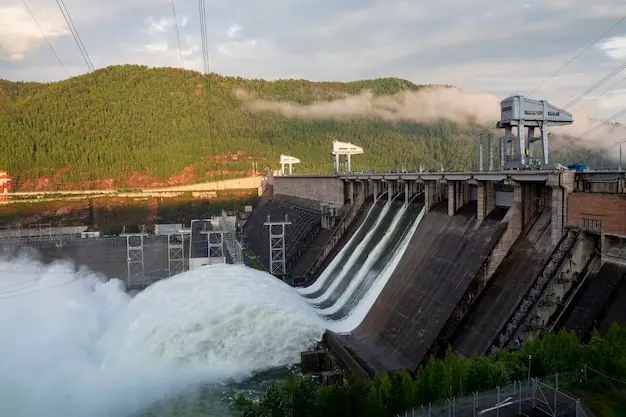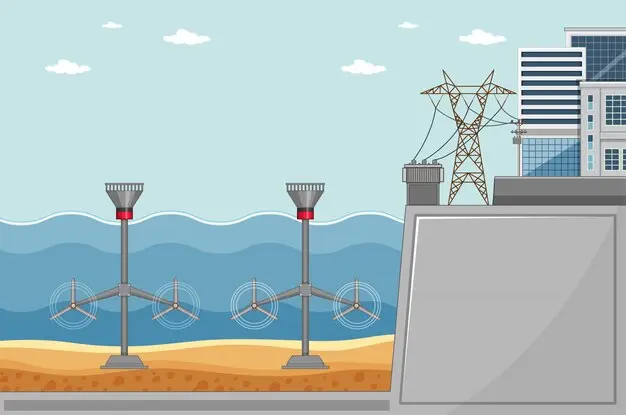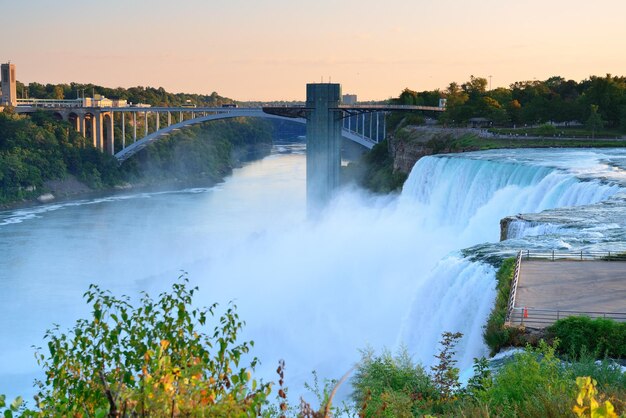Water energy, also known as hydro energy or hydroelectric power, is a form of renewable energy derived from the force or energy of moving water. It’s a clean, green, and eco-friendly power source that can play a significant role in reducing our reliance on fossil fuels and making our energy consumption more sustainable.
From the rushing waters of our mighty rivers to the ceaseless tides of our vast oceans, the power of water is all around us. This blog post will delve into the world of water energy, exploring its potential, its applications, and its benefits. We’ll also look at the challenges we face in harnessing this power and the innovations that are helping us overcome these obstacles. Whether you’re a newly married couple looking to power your first home, an environmental enthusiast, or simply someone interested in sustainable living, this exploration of water energy promises to be an enlightening journey.
So, let’s dive in and explore the untapped potential of water as a sustainable energy source.
Key Takeaways
- Water as a Sustainable Energy Source: Water, in its various forms, holds immense potential as a renewable, reliable, and eco-friendly source of energy. This includes hydroelectric power from rivers, tidal power from ocean currents, and wave energy from ocean waves.
- Harnessing the Power of Water: The energy in moving water, driven by gravity, can be harnessed and converted into electricity. This process involves capturing the kinetic energy of water using turbines and converting this mechanical energy into electrical energy using generators.
- Environmental Impacts and Challenges: While water energy is a clean source of power, its extraction and use can have significant environmental impacts, including changes to land use and local ecosystems. However, these impacts can be mitigated with careful planning, environmental assessments, and sustainable practices.
- Water Energy and Climate Change: Water energy can play a crucial role in our response to climate change. By replacing fossil fuels with water energy, we can significantly reduce our greenhouse gas emissions and help mitigate the effects of global warming.
- Innovations in Water Energy: The field of water energy is advancing rapidly, with numerous innovative technologies under development. These include new types of tidal stream generators, wave energy converters, and even ‘energy islands’ that combine multiple forms of renewable energy.
- The Future of Water Energy: With ongoing advancements in technology and a growing emphasis on sustainability, water energy has the potential to play a significant role in our transition to a sustainable energy future. By harnessing the power of water, we can power a greener and more sustainable future.
The Power of Water: An Untapped Resource
Harnessing the Energy of Moving Water
Water, the lifeblood of our planet, is an untapped resource with immense potential for energy generation. The energy produced by water is not only renewable, but it’s also reliable and consistent. Unlike solar and wind energy, which are dependent on weather conditions, water energy can be harnessed regardless of the time of day or season.
The Role of Gravity in Water Energy
The secret to water’s energy potential lies in its movement and the force of gravity. When water moves from a higher elevation to a lower one, it releases kinetic energy. This energy can be captured and converted into electricity, a process known as hydroelectric power. It’s a simple yet effective method of energy conversion that has been used for centuries, from the waterwheels of ancient civilizations to the sophisticated hydroelectric dams of today.
Exploring the Power of Oceans
But the power of water extends beyond rivers and streams. Our oceans, covering more than two-thirds of the Earth’s surface, are a vast and largely untapped source of energy. The constant ebb and flow of tides, driven by the gravitational pull of the moon and the sun, can generate tidal power. Similarly, the energy of ocean waves can be harnessed to produce wave energy.
Overcoming Challenges and Looking to the Future
Harnessing the power of water for energy generation is not without its challenges. It requires significant infrastructure and can have environmental impacts. However, with advanced technology and a commitment to sustainability, these challenges can be overcome. As we continue to explore and innovate, the potential of water as a sustainable energy source becomes increasingly clear. It’s a potential that could play a crucial role in our transition to a greener, more sustainable future.
Hydroelectric Power: Turning Water into Electricity
Hydroelectric power is one of the oldest and most established forms of renewable energy. It’s a method of generating electricity by converting the energy into flowing or falling water. This process is not only renewable but also emits no greenhouse gases, making it a clean and eco-friendly power source.
The Role of Dams and Water Turbine Systems
The most common method of generating hydroelectric power involves the use of dams. A dam is built across a river to create a reservoir or storage area. When released, the water in the reservoir flows down through a pipe and pushes against the blades of a turbine. As the turbine spins, it drives a generator that converts the kinetic energy of the moving water into electrical energy. This electricity is then transmitted to homes, businesses, and industries through a network of power lines.
The Benefits and Challenges of Hydroelectric Power
Hydroelectric power offers several benefits. It’s a reliable and predictable source of energy, as the flow of water can be controlled and the electricity generated can be adjusted to meet demand. It also helps in water supply and irrigation, and the reservoirs created by dams can be used for recreation.
However, hydroelectric power also has its challenges.
The construction of dams can have significant environmental impacts, including changes to ecosystems, displacement of local communities, and potential risks related to dam failure.
It’s crucial that these challenges are addressed through careful planning, environmental assessments, and sustainable practices.
Despite these challenges, hydroelectric power remains a key component of the world’s renewable energy mix. With ongoing advancements in technology and a growing emphasis on sustainability, the future of hydroelectric power looks promising.

Tidal Power
Tidal power, also known as tidal energy, is another form of water energy that harnesses the natural ebb and flow of ocean tides to generate electricity. It’s a form of hydropower that converts the energy obtained from tides into useful forms of power, mainly electricity.
How Tidal Power Works
Tides are more predictable than wind energy and solar power. As the sea level rises and falls, tidal power systems generate electricity from the kinetic energy of moving water.
Tidal power can be harnessed in several ways, but the most common method involves the use of tidal stream generators.
Similar to wind turbines, these generators capture the kinetic energy of moving water and convert it into electrical energy.
The Potential and Challenges of Tidal Power
Tidal power holds great potential.
It’s a renewable source of energy that can contribute to our energy mix, reduce our reliance on fossil fuels, and help mitigate the effects of climate change.
Moreover, tides are predictable and reliable, making tidal power a more consistent source of energy than some other forms of renewable energy.
Like all forms of energy, tidal power comes with its own set of challenges. These include high upfront costs, potential impacts on marine life, and the need for specific geographical conditions – not all coastal areas are suitable for tidal power generation.
Despite these challenges, with continued research and technological advancements, tidal power has the potential to become a significant contributor to our sustainable energy future.

Wave Energy
Wave energy, or ocean wave power, is a form of renewable energy that harnesses the power of ocean waves.
Waves are generated by the wind as it blows across the sea surface, transferring its energy to the water.
This energy can be captured and converted into electricity, providing a sustainable and renewable source of power.
How Wave Energy Works
There are several methods of harnessing wave energy, but most involve the use of wave energy converters (WECs) – devices that absorb the energy of ocean waves and convert it into electricity.
Some WECs are installed offshore, floating on the surface of the water or anchored to the seafloor, while others are installed onshore or near the shore.
Wave Power Devices and Wave-to-Electricity Conversion
Wave power devices, such as buoys, turbines, and oscillating water columns, capture the physical movement of waves and convert them into mechanical energy.
This mechanical energy is then converted into electrical energy, which can be transmitted to the grid and distributed to homes and businesses.
The Potential and Challenges of Wave Energy
Wave energy holds significant potential as a renewable energy source. It’s abundant, renewable, and more consistent than wind and solar energy.
Moreover, since the majority of the world’s population lives in coastal areas, wave energy could provide a local source of power for many communities.
However, wave energy also faces several challenges. These include technical challenges related to the harsh marine environment, the variability of waves, and the need for robust and efficient wave energy converters.
There are also environmental and aesthetic considerations, as well as regulatory and financing challenges.
Despite these challenges, the field of wave energy is advancing rapidly, with numerous innovative technologies under development.
As we continue to innovate and improve these technologies, wave energy could play an increasingly important role in our transition to a sustainable energy future.
The Ecological Impact of Water Energy
Harnessing the power of water for energy generation is not without its environmental implications. While water energy is a renewable and clean source of power, its extraction and use can have significant impacts on land use and local ecosystems.
For instance, the construction of dams for hydroelectric power can lead to the flooding of large areas, causing displacement of local communities and wildlife.
Additionally, changes in water flow can impact aquatic habitats and affect species that rely on these ecosystems.
Sustainability Challenges of Water Energy
The sustainability of water energy also depends on factors such as water availability and climate conditions. In regions where water resources are scarce or subject to seasonal variations, the reliability of water energy can be affected.
Moreover, climate change, with its potential to alter rainfall patterns and increase the frequency of extreme weather events, poses additional challenges to the sustainability of water energy.
Balancing Energy Generation and Environmental Protection
Despite these challenges, it’s important to note that with careful planning and management, the environmental impacts of water energy can be mitigated.
Environmental impact assessments, sustainable design principles, and adaptive management strategies can help balance the need for renewable energy with the need to protect and preserve our natural environments.
Water Energy and Global Warming
The Role of Water Energy in Reducing Greenhouse Gas Emissions
As the world grapples with the challenges of climate change, the transition to renewable energy sources like water energy becomes increasingly important.
Unlike fossil fuels, which release carbon dioxide and other greenhouse gases when burned, water energy is a clean source of power that produces no direct emissions. By replacing fossil fuels with water energy, we can significantly reduce our greenhouse gas emissions and help mitigate the effects of global warming.
Water Energy and Our Carbon Footprint
Moreover, water energy can help us reduce our carbon footprint in other ways.
For instance, hydroelectric dams often create reservoirs that can be used for multiple purposes, such as irrigation, drinking water supply, and recreation.
This multi-purpose use of infrastructure can lead to additional reductions in greenhouse gas emissions.
The Future of Water Energy in a Warming World
However, it’s important to note that while water energy has a crucial role to play in our response to climate change, it’s not a silver bullet.
The impacts of climate change, such as altered rainfall patterns and rising sea levels, can affect the availability and reliability of water energy.
Therefore, it’s essential to consider water energy as part of a diverse mix of renewable energy sources, each contributing to a sustainable and climate-resilient energy future.
Water Energy in Electricity Production
Water energy plays a significant role in electricity production worldwide.
From small-scale micro-hydro systems in remote communities to large-scale hydroelectric dams powering major cities, water energy is a key component of our energy mix.
It’s a reliable and flexible source of power that can be adjusted to meet varying electricity demands.
The Process of Energy Conversion in Water Energy Systems
The process of energy conversion in water energy systems is relatively straightforward. Whether it’s the kinetic energy of flowing water in a river or the potential energy of tides in the ocean, the principle is the same.
Water energy systems capture this energy, convert it into mechanical energy through turbines, and then convert this mechanical energy into electrical energy through generators.
This electricity is then transmitted to the grid and distributed to consumers.
The Efficiency of Water Energy Systems
Water energy systems are also highly efficient. Modern hydroelectric power plants can convert over 90% of the available energy into electricity, making them one of the most efficient forms of energy generation. Moreover, because water is a dense medium (it’s about 800 times denser than air), even slow-moving water can generate significant amounts of energy.
Innovations in Water Energy
Advancements in Water Energy Technology
As we strive to harness the full potential of water as a sustainable energy source, innovation and technological advancement are key.
Researchers and engineers worldwide are working on new and improved ways to capture and convert water energy more efficiently and sustainably.
The Future of Hydro Power Plants and Water Turbine Systems
In the realm of hydroelectric power, for instance, there’s a growing interest in ‘run-of-river’ systems that generate electricity without the need for large dams and reservoirs. These systems have a lower environmental impact and can be a viable option for smaller rivers and streams.
Similarly, advancements in turbine technology are improving the efficiency and environmental performance of hydroelectric power plants.
For example, fish-friendly turbines are being developed to reduce the impact on aquatic life.
Innovations in Tidal and Wave Energy
In the field of tidal and wave energy, innovative technologies are emerging that promise to increase the viability and accessibility of these energy sources. These include new types of tidal stream generators, wave energy converters, and even ‘energy islands’ that combine multiple forms of renewable energy.
Conclusion
As we navigate through the complexities of our energy needs and the pressing urgency to mitigate climate change, the potential of water as a sustainable energy source shines brightly on the horizon. From the kinetic energy of our vast rivers to the rhythmic dance of our ocean tides and waves, water presents a renewable, reliable, and eco-friendly power source that can significantly contribute to our global energy mix.
The journey through this blog post has taken us from understanding the basics of water energy to exploring its various forms – hydroelectric power, tidal power, and wave energy. We’ve delved into the environmental impacts, the challenges, and the innovations that are shaping the future of water energy.
The road to a sustainable future is not without its hurdles, but with continued research, technological advancements, and a commitment to sustainable practices, we can overcome these challenges. The future of water energy is not just about harnessing power but also about fostering resilience, promoting equity, and preserving our planet for generations to come.
Whether you’re a newly married couple powering your first home, an environmental enthusiast, or a sustainable living advocate, we hope this exploration of water energy has been enlightening. As we continue to innovate and harness the power of water, we are not just riding the wave to a sustainable future, but we are also creating it.
Frequently Asked Questions (FAQs)
-
What is water energy?
Water energy, also known as hydro energy or hydroelectric power, is a form of renewable energy that harnesses the power of moving water to generate electricity. This can include the energy from rivers, tides, and ocean waves.
-
How does water energy work?
Water energy works by capturing the kinetic energy of moving water. This energy is then converted into mechanical energy using turbines, and this mechanical energy is converted into electrical energy using generators.
-
Is water energy renewable?
Yes, water energy is a renewable source of energy. As long as the water cycle continues, we will have access to water energy. This makes it a sustainable and environmentally friendly source of power.
-
What are the benefits of water energy?
Water energy is clean, renewable, and reliable. It does not emit greenhouse gases, it can be produced consistently, and it can be adjusted to meet varying electricity demands. It also has the potential to support local economies and contribute to energy security.
-
What are the challenges of water energy?
The challenges of water energy include environmental impacts, high upfront costs, and the need for specific geographical conditions. However, with careful planning and management, these challenges can be mitigated.
-
What is the future of water energy?
The future of water energy looks promising. With ongoing advancements in technology and a growing emphasis on sustainability, water energy has the potential to play a significant role in our transition to a sustainable energy future.

